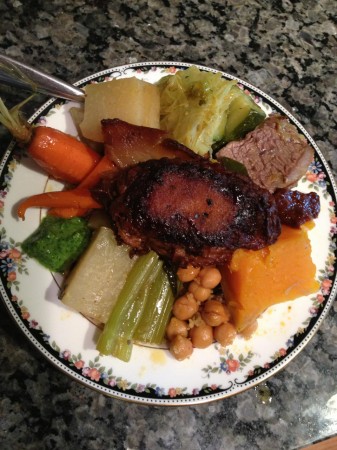By Kristina Meyer (trixie-pea)
Ingredients
For the broth/stew
olive oil
kosher salt
2-3 beef short ribs
1-2 beef shanks with a large marrow bone
1 large yellow onion, thinly sliced
1 T. tumeric
1 T. cayenne pepper
1 cinnamon stick
2 T. coriander seed
1 T. cumin seed
2 T. ras el hanout *
10 black peppercorns
1 head of garlic, peeled and chopped finely
parsley stems from one bunch of parsely, chopped finely
1 poblano, chopped
1 quart chicken stock
2 large carrots, peeled and cut into large chunks
3 celery stalks, cut into large chunks
2 whole chicken legs (leg-thigh quarter)
* a traditional Arabic spice blend common to Muslim and Sephardic cuisines. Available at The Spice House or most Middle Eastern markets.
For the boulettes
1.5 lbs. ground chuck
about 1 T. kosher salt
1 T. ras el hanout *
1 T. ground coriander
½ T. ground cumin
2 t. ground black pepper
1 T. cayenne pepper
¼ cup flat leaf parsley, finely chopped
1 medium onion, grated into a bowl
8-10 cloves of garlic, finely minced
1 egg yolk
2 large russet potatoes, peeled
2 cups all-purpose flour
large bowl of salty water to soak the potatoes
olive oil
For the chickpeas
1 can of chickpeas
juice of 1 lemon
1 T. harissa
salt to taste
For the parsley sauce
1 bunch of parsley
1 clove of garlic
4-5 T. olive oil
juice of 1 lemon
¼ cup water
salt to taste
For the harissa
4-5 dried ancho chiles
4-5 dried chile de arbol
5 cloves garlic
2 roasted red peppers (pimentos)
1 T. tomato paste
1 T. ground coriander
1 T. ground cumin
2 T. wine vinegar
4 T. olive oil
salt and pepper to taste
For the couscous
4 cups whole wheat couscous
4 T. butter, melted
1 cup hot, salted water (using 1 t. salt)
For the vegetables
5 small carrots, peeled
4 stalks celery, cut into 3-inch pieces
2 large kohlrabi, peeled and cut into 1 ½ inch cubes (may substitute daikon radish)
2 zucchini, cut into 1½ inch rounds
1 head savoy cabbage, cut into 6 wedges
1 large or 2 small butternut squash, cut into quarters
Olive oil
Salt to taste
Method
Allow yourself an entire day to make this dish. Start in the late morning and you can be eating by 7 p.m. This recipe will serve 4-6 people and is easy to scale up for a crowd. Technically you could halve the recipe, but I’m not sure why anyone would – just invite more friends over for dinner!
PART ONE: The broth
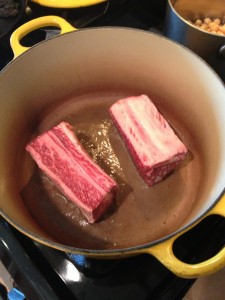 Season the short ribs and shanks generously with salt. Meanwhile, heat a large dutch oven over medium heat. Brown the beef short ribs and beef shanks in olive oil, working in batches so as to not crowd your pan and to achieve a deep brown color on all sides of each cut. Set aside on a platter while you create the flavor base for the stew.
Season the short ribs and shanks generously with salt. Meanwhile, heat a large dutch oven over medium heat. Brown the beef short ribs and beef shanks in olive oil, working in batches so as to not crowd your pan and to achieve a deep brown color on all sides of each cut. Set aside on a platter while you create the flavor base for the stew.
Traditionally, just the shank and maybe some neck bones would be used to flavor the stew. I like to add the short ribs to the recipe for the rich flavor and gelatin they add to the broth, as well as the succulent meat that results. It’s a luxurious addition to the final plate, but with or without them the dish will still be wonderful. If you don’t use ribs, just double up on the shanks.
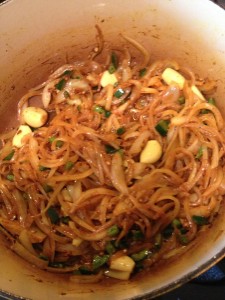 2. In the same Dutch oven, sauté the onions in the beef fat, working to scrape up any brown bits from the surface of the pot. Add a pinch of salt to the onions to help them release their liquid. Add all the spices into the pot and stir to incorporate the spices into the oil. If the pot seems dry, add 1 T. of olive oil to moisten. Once the spices are fragrant, add the tomato paste and fry the paste until it has caramelized and turned a dark reddish-brown. Then add the rest of the aromatics: parsley stems, garlic, green pepper plus 1 T. salt, and sauté until softened.
2. In the same Dutch oven, sauté the onions in the beef fat, working to scrape up any brown bits from the surface of the pot. Add a pinch of salt to the onions to help them release their liquid. Add all the spices into the pot and stir to incorporate the spices into the oil. If the pot seems dry, add 1 T. of olive oil to moisten. Once the spices are fragrant, add the tomato paste and fry the paste until it has caramelized and turned a dark reddish-brown. Then add the rest of the aromatics: parsley stems, garlic, green pepper plus 1 T. salt, and sauté until softened.
3. Add 1 quart of chicken stock; scrape up all the bits from the bottom of the pan. Add the two chicken legs, carrots, celery, browned beef shank, short ribs and any juices and fat that have dripped from the beef cuts back to the broth. Return to a simmer.
PART TWO: The boulettes
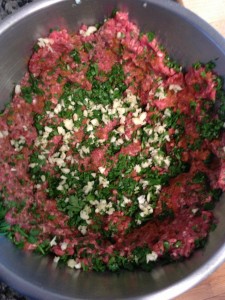 While the stew is simmering you can make the boulettes – a sort of vegetable-wrapped oblong meatball that is breaded, fried and braised.
While the stew is simmering you can make the boulettes – a sort of vegetable-wrapped oblong meatball that is breaded, fried and braised.
1. Traditionally, the boulettes are made with very coarsely ground or hand-chopped meat. I make them with high-quality ground chuck from the butcher. Keep two key things in mind when you are making the boulettes: first, make sure the meat is properly seasoned; second, do not overwork the meat. In order to accomplish this, take a large bowl and lightly press the ground beef into about a 1-inch layer all around the bowl. This way, as you add the seasonings, you have a better feel for what the correct amount should be.
2. Add seasonings one at a time, evenly distributing the ingredients in layers over the meat. Start with salt, spices, garlic and parsley. Squeeze all of the moisture out of the soaked bread before adding to the meat. You’ll also want to remove all of the “water” from the shredded onion, too. Don’t waste that onion water, though – squeeze all of the onion juice directly into the simmering stew for extra flavor.
3. Add an egg yolk and combine the meat mixture thoroughly with your hands. Be careful to just combine the meat spices without over-mixing – otherwise, your final boulette will have an undesirably smooth texture. Take a small piece of the seasoned meat, microwave it for 10-15 seconds and taste it. Adjust seasonings as needed. As you’ll be braising in a flavorful and reduced broth, which will add additional salt, the meat should taste slightly under-salted. Cover and chill while you prepare the potato wraps.
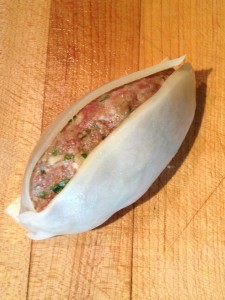 4. This recipe should yield 12-14 boulettes. These football-shaped meatballs are traditionally wrapped in some sort of thinly-sliced vegetable – like eggplant, onion, zucchini, or even celery.
The preferred wrap in the the Lopata household was potato. The potato browns well, maintains structural integrity and is a great carrier of flavor. Meme and Coco would painstakingly carve each strip of potato by hand with a paring knife. The curvature of their cuts would dictate the shape of their boulette. I figured out a simpler method that yields a more consistent wrap and saves literally hours of work. I use a mandoline to slice the potato into thin sheets, about 1/8-inch thick. The potato sheets need to be soaked in salt water for about five minutes to both season them and make them more pliable. Cut the potato sheets into strips that are approximately 3” long x 1” wide. This doesn’t have to be perfect, but trimming up the strips makes for easier assembly. The chunk trimmings from the potatoes can get thrown into the simmering broth. Do not waste!
4. This recipe should yield 12-14 boulettes. These football-shaped meatballs are traditionally wrapped in some sort of thinly-sliced vegetable – like eggplant, onion, zucchini, or even celery.
The preferred wrap in the the Lopata household was potato. The potato browns well, maintains structural integrity and is a great carrier of flavor. Meme and Coco would painstakingly carve each strip of potato by hand with a paring knife. The curvature of their cuts would dictate the shape of their boulette. I figured out a simpler method that yields a more consistent wrap and saves literally hours of work. I use a mandoline to slice the potato into thin sheets, about 1/8-inch thick. The potato sheets need to be soaked in salt water for about five minutes to both season them and make them more pliable. Cut the potato sheets into strips that are approximately 3” long x 1” wide. This doesn’t have to be perfect, but trimming up the strips makes for easier assembly. The chunk trimmings from the potatoes can get thrown into the simmering broth. Do not waste!
5. Before assembling the boulettes, prepare breading and frying “stations” so you are ready to go after the meatballs have been formed. In one bowl, beat three eggs, ¼ cup of water and a pinch of salt. Put about 2 cups of all-purpose flour in another wide, shallow bowl somewhere close to your stove.
6. Remove the meat mixture from the refrigerator and lay it out with your potato strips next to your workstation. To form the boulette, take about 2 ounces of meat (slightly smaller than a billiard ball’s worth) and form it into a torpedo shape, about 3 inches long. Then take a strip of damp potato, lay it on the meatball lengthwise and press it in slightly so that it adheres to the meat. Apply two more potato strips, leaving about a ¼-inch of meat ball exposed between strips.
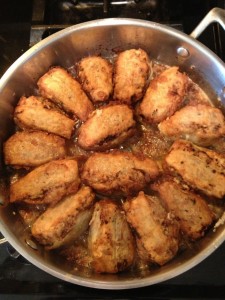 7. Prepare a large, shallow pan with a lid. It needs to be about 16-18 inches wide in order to hold all of the boulettes at once for the braise. Heat ½ cup of olive oil over medium-high heat. Since pan size will vary, make sure there is a generous amount of olive oil. Working in 2-3 batches so the boulettes have room to brown (not steam) in the pan, coat each in flour (do not shake off too much of the excess flour), then dip it into the egg mixture and place it directly into the sauté pan. Pan should sizzle but not smoke when you add each one. Adjust heat as necessary. Continue to brown on all sides until golden brown. Remove, reserve.
7. Prepare a large, shallow pan with a lid. It needs to be about 16-18 inches wide in order to hold all of the boulettes at once for the braise. Heat ½ cup of olive oil over medium-high heat. Since pan size will vary, make sure there is a generous amount of olive oil. Working in 2-3 batches so the boulettes have room to brown (not steam) in the pan, coat each in flour (do not shake off too much of the excess flour), then dip it into the egg mixture and place it directly into the sauté pan. Pan should sizzle but not smoke when you add each one. Adjust heat as necessary. Continue to brown on all sides until golden brown. Remove, reserve.
8. When finished, add them all back to the pan so they are packed in fairly snugly – touching, but all in a single layer. Add all residual juices as well. Turn heat to medium-high and as soon as they start sizzling, add about 1½ cups of the stew broth directly into the pan. The liquid should come about ¼-inch up the side. Reduce the heat to medium-low and simmer partially covered, until the liquid has reduced to a deep mahogany “gravy” – about one hour, maybe slightly longer.
This is the part of the process where you need to have faith, or temporarily adopt it if you don’t already have some. The first time you do this, you will not believe that the the meatballs are going to stay together, and you definitely won’t believe that the potato wrapper will remain attached through the braise, but boulettes are small miracles both in engineering and flavor. Do not fret!
At this point most of the hard work is done. Your broth is starting to taste really good. This is also a good time to take a break. Clean up your kitchen, have a glass of wine or a smoke. When you come back, you’ll start the final phases of couscous – vegetables, legumes and condiments!
PART THREE: The chickpeas
Take a can of chickpeas and ladle most of the beef fat that has surfaced on the stew over the chickpeas. Simmer for about an hour. The chickpeas will absorb the flavor of from the spiced fat. Before serving add the juice of one lemon, a tablespoon of harissa and salt to taste.
PART FOUR: The condiments
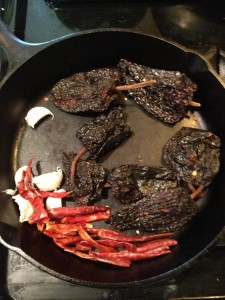 The two condiments involved are harissa, a Tunisian hot pepper sauce, and a totally made-up parsley sauce that I improvised a few years back. The latter adds back a little freshness and acidity to the final dish and the former provides spice and richness. If you like it a little spicier, try leaving some of the seeds in the chiles.
Traditionally, salty preserved lemons were always served alongside the meal. If you are using a food processor, which I recommend, make the parsley sauce first, and then you don’t even have to wash out the processor bowl before you begin the harissa.
The two condiments involved are harissa, a Tunisian hot pepper sauce, and a totally made-up parsley sauce that I improvised a few years back. The latter adds back a little freshness and acidity to the final dish and the former provides spice and richness. If you like it a little spicier, try leaving some of the seeds in the chiles.
Traditionally, salty preserved lemons were always served alongside the meal. If you are using a food processor, which I recommend, make the parsley sauce first, and then you don’t even have to wash out the processor bowl before you begin the harissa.
1. In a food processor or blender, combine parsley, garlic, olive oil and salt. Blend until smooth, add water until it makes a smooth and pourable sauce, about the consistency of a creamed soup – though a little chunky is fine. Cover and set aside.
2. Over medium heat, toast chile peppers in a dry skillet until fragrant and pliable, about five minutes. Also, heat the garlic cloves through, with their skins still on. in the same skillet. Meanwhile, bring about 1 cup of water to a boil. When chiles are toasted, cut them open with kitchen shears and remove the stems and seeds. Place the de-seeded chiles in the boiling water, turn off the heat and cover. Let steep 10 minutes.
3. In the bowl of the same food processor or blender you used to make the parsley sauce, add the chiles, peeled garlic, tomato paste, roasted red peppers, spices, salt, and vinegar. Blend until smooth. Taste and adjust for seasoning. Add olive oil to thin to desired consistency.
PART FIVE: The couscous
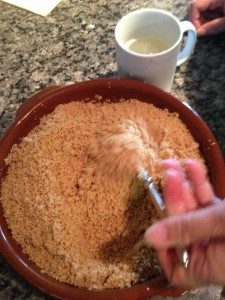 Preheat the oven to 350° F. Place the couscous in a earthenware or ovenproof dish and pour the melted butter on top. Massage the butter into the pasta until each granule is coated with fat. Heat 1 cup of water with 1 t. salt until very hot. Sprinkle this salty water over the buttered couscous to moisten the pasta. Place it in the oven to steam-roast. Check on its progress every 15 minutes or so, mixing and adding water if necessary. The couscous is done when it is soft enough to bite through, but it should still have some fight left in it.
Preheat the oven to 350° F. Place the couscous in a earthenware or ovenproof dish and pour the melted butter on top. Massage the butter into the pasta until each granule is coated with fat. Heat 1 cup of water with 1 t. salt until very hot. Sprinkle this salty water over the buttered couscous to moisten the pasta. Place it in the oven to steam-roast. Check on its progress every 15 minutes or so, mixing and adding water if necessary. The couscous is done when it is soft enough to bite through, but it should still have some fight left in it.
Using the whole-wheat couscous gives the dish a nuttier flavor, closer to the bulgur wheat that was used once upon on a time. It’s difficult to overcook. Once couscous is done (30-40 minutes), cover and keep warm in the oven.
PART SIX: The vegetables
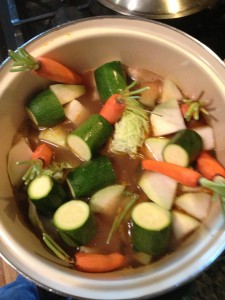
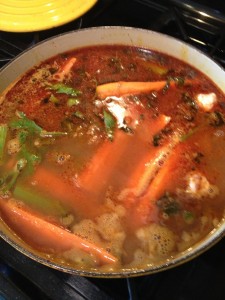 Transfer the stew to a large stockpot and bring to a boil. Remove short ribs and set aside for service. Taste the broth. It should be rich and slightly salty. Adjust seasoning. Add your vegetables and enough water to almost cover them. It’s okay if some of them are sticking out of the top of the liquid.
Cover and boil until done, about 20-30 minutes. You do not want your vegetables to be toothsome; they should be very soft – cut-with-a-spoon soft. Let the vegetables rest in the broth until ready to serve. Re-adjust the seasoning to make sure the broth tastes like a savory soup.
Transfer the stew to a large stockpot and bring to a boil. Remove short ribs and set aside for service. Taste the broth. It should be rich and slightly salty. Adjust seasoning. Add your vegetables and enough water to almost cover them. It’s okay if some of them are sticking out of the top of the liquid.
Cover and boil until done, about 20-30 minutes. You do not want your vegetables to be toothsome; they should be very soft – cut-with-a-spoon soft. Let the vegetables rest in the broth until ready to serve. Re-adjust the seasoning to make sure the broth tastes like a savory soup.
PART SEVEN: Service!
I feel sorry for anyone who didn’t grow up with some sort of boiled dinner – i.e. corned beef and cabbage, crawfish boils, pot au feu, cocido. As bland as they sound on paper, these are some of the most flavorful, soul-satisfying dishes imaginable. Couscous is no exception. Once the spices permeate the vegetables, they transform into something brand new.
Remove the vegetables from the broth and lay out on a platter. Drizzle a little olive oil over the vegetables and season with a few pinches of coarse salt. The broth can be served in a terrine so diners can moisten their bowls of couscous as they like. Trim and slice the short ribs and lay out on a platter with the shank meat and boulettes.
In a wide, shallow bowl place a small mound of couscous. Moisten the couscous with ¼ cup of broth. Place a few pieces of each vegetable, chickpeas, short rib and a boulette on top. Garnish with parsley sauce and harissa and eat it in good health.
To return to the main article, click here.


